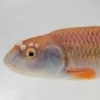Well if you get too annoyed I'd be glad to take them off of your hands! he. he.Update on the fish: I saw one of the females today. She was striped dark brown on sand brown, kind of like the dinosaurs on the Jurassic Park movie. And it looked like someone had given her a black eye.
I couldn't take a photo because they still hate people too much. These fish are starting to annoy me, with how little I see them and how shy they are. 99% of the time, it's as if the tank is empty.
Just don't use them for bait as one former NANFA did with the fish he was going to send me until someone said something that offended him. No joke.(that individual) does not represent most nanfa members)
Anyway I think I may have mentioned before after several months they become less shy. Also it is fun for a super geek like me to check in on them with a flashlight, Kind of cool to see what is going on at night. Try it, maybe you can be a hardcore fish geek too!


 This topic is locked
This topic is locked





